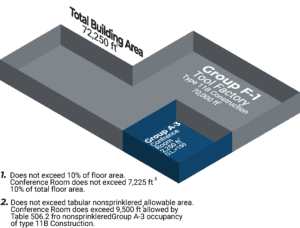Protecting Accessory Uses in the 2021 IBC

What are accessory uses and how are they regulated?
Accessory uses are considered minor uses in the overall occupancy of the building. These uses are often necessary or complimentary to the function of the building’s major use. The accessory occupancy is assigned to the occupancy based on its own unique characteristics. There are two considerations when accessory uses are present. They are allowable building height and allowable building area. While there are a few requirements that accessory uses must follow, they are still subject to permittable building heights and areas of Section 504 of the 2021 IBC.
Additionally, the allowable area of the building is based on the applicable provisions of Section 506 of the IBC. However, the allowable aggregate area of the accessory use is not permitted to occupy more than 10% of the floor area of the story where they are located, while at the same time not exceeding the tabular values for non-sprinklered buildings in Table 506.2. Finally, there is no separation required between the accessory use and main occupancy except for a couple of exceptions. How are accessory uses protected?
Proper viewing of accessory uses.
While maintaining the philosophy of a mixed-use building, accessory uses permit such relatively small accessory occupancies to be considered merely a portion of the major occupancy for separation purposes. A good example would be a lunchroom seating 120 persons and located in a large manufacturing facility. The individuals using the lunchroom are generally the same individuals who work elsewhere in the factory, the hazards encountered while they are occupying the lunchroom are quite different from those created in the manufacturing environment.
Another example would be that a small office space in a factory could be considered an accessory occupancy as long as it complies with the provisions of Section 508.2. So, the office space would be classified as a Group B occupancy.
How are accessory uses protected?
 There is one sentence in Section 508.2.1 that provides the protection requirements. It simply says that all the other requirements of this code (2021 IBC) apply to each portion of the building based on the classification of that space. This means the protection requirements of the accessory use only applies to that space and the requirements of the major use only apply to the major use portion.
There is one sentence in Section 508.2.1 that provides the protection requirements. It simply says that all the other requirements of this code (2021 IBC) apply to each portion of the building based on the classification of that space. This means the protection requirements of the accessory use only applies to that space and the requirements of the major use only apply to the major use portion.
Chapter 9 of the 2021 IBC will lay out the requirements of each space accordingly. In most cases only one type of sprinkler system would apply, and thus one standard. Often, a NPFA 13 system would be applied to all the areas and protect them properly.
BENEFITS OF NFSA MEMBERSHIP
NFSA staff work closely in the codes and standards development process through NFPA and the International Code Council touting the benefits of fire sprinklers in the built environment. Our team of experts stays on the forefront of fire protection issues. For more information on NFSA’s mission to protect lives and property through the widespread acceptance of the fire sprinkler concept, to learn more about the benefits of NFSA membership, or to join our association, please visit our membership page to learn more.
